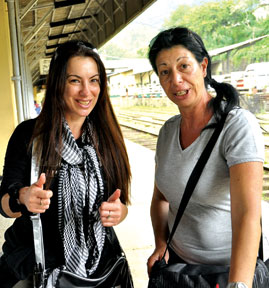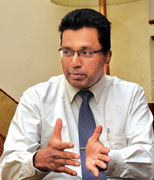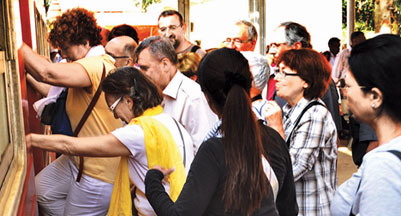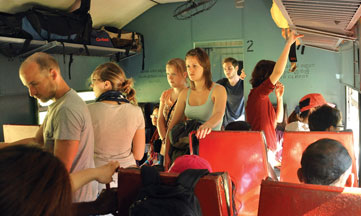Spending pattern of tourists changing
By Gamini Warushamana
Estner Krieken and Marlon Donkers from Holland are on a long tour of
Sri Lanka, Thailand, Cambodia and Laos. They said that their budget for
the whole trip was around 3,000 Euro per person and the budget in Sri
Lanka is only 700 Euro per person for the three weeks they are staying
here and it is less than Rs. 6,000 per day per person.
 |
|
Clare Muscat and Doreen
Falzon |
 |
|
Tyrone David |
Last week they were travelling in a second-class compartment of the
Colombo-Badulla train which was packed with passengers including around
100 foreign tourists. Most of them were standing and Estner and Marlon
too were standing on the foot-board all through the journey from
Peradeniya to Talawakele and their destination was Nuwara Eliya. Nurses
by profession, they could be classified as lower middle-class tourists.
Their spending power was obviously low.
Clare Muscat and Doreen Falzon from Malta too could be classified as
middle-class and they too sought rooms at around Rs. 2,000 per day.
Air hostesses by profession at Air Malta, their budget in Sri Lanka
is 50 Euros (around Rs. 8,500) a day per person.
Tourists in this category who stay at cheap hotels, travel by public
transport and dine at cheap restaurants, are common in this new
development era of the tourism industry in Sri Lanka.
The tourism industry in Sri Lanka is growing fast. The government
targets a revenue of $ 2.5 billion from the industry by 2016.
While the number is growing there are changes taking place in the
composition of the tourists and to facilitate growth, the authorities
must understand these changes and unless their plans are based on
hypothetical conditions they may not get the desired results.
One argument of critics is that although the number is increasing
their spending power is far less and they are classified as cheap
tourists. However, the statistical evidence does not support this
argument and the foreign exchange receipts per tourist per day is
increasing and it has increased by $ 10, from US $ 88 to US $ 98 in 2011
compared to the previous year.
The benefits of the industry trickle down to the people through this
segment of tourists. Stakeholders of the industry such as taxi drivers,
small hotels and restaurant owners say that they benefit only from this
category.
High-end tourists who come through tour operators, stay at luxury
hotels, travel by luxury buses owned by big hotels or travel operators,
bring nothing directly to those who also look for some benefits from the
growing tourism industry.
Another feature of this segment of tourists is that they do not
depend on travel operators or tourist guides.
Clare, Doreen, Estner and Marlon and almost all others who were in
the train had organised their trip on their own after searching for
information on the internet. They did not have a place to stay in Nuwara
Eliya or Kandy until they came to the cities. They planned their route
getting information from hotels they stayed in or from others they
encountered on their journeys.
 |
|
Scrambling to get into
a train |
 |
|
Tourists locating
seating accomodation in the train. |
For instance, Magdalena, a German girl we met on the train was
travelling directly to Kandy without staying in Negombo or Colombo
because according to her information, hotel rooms were expensive.
After a long journey from Frankfurt via Bangkok she was extremely
tired and was sleeping all the way. Until she got down at Peradeniya
railway station she did not have any idea about a place to stay in.
However, she was confident of finding a room at around Rs. 2,000 per day
in Kandy.
Another advantage of this low-budget tourists is that they act as the
main promotional channel of Sri Lanka as a destination.
The experience they share with others when they return to their home
countries is stronger than any publicity campaign.
The residential manager of the Grand Hotel, Nuwara Eliya, the most
expensive hotel in the city, Tyrone David said that there is a marked
increase in the number of high-end tourists as well.
The composition of tourists has changed over the past four years.
Today, the occupancy rate of the hotel, which has 153 rooms, is over 87
percent. Group travellers are less and individuals who book at the hotel
through the internet has been increasing.
Tourists arriving from Middle Eastern countries have been increasing
and Nuwara Eliya is an ideal tourism product to market in the Middle
East.
Their spending power is high and they also come with families and
stay longer periods, he said.
Apart from peace and security in the country there are other factors
that support the growth of the tourism industry.
When we consider the development of communication, internet and
transportation in the world over the past decade, travellers are better
informed and the cost of travelling has decreased and become affordable
for ordinary people in developed and emerging economies.
Tourism is considered an information-intensive industry that can gain
important synergies from the use of the internet. The tourism sector has
been a pioneer in adopting and developing ICT applications and today it
is rated among the top product or service categories purchased via
internet in all parts of the world.
The growing middle-class in emerging economies too have created
demand. Therefore, there is a spectrum of tourists with varied spending
power. Hence the availability of tourism information in the internet is
vital today.
The authorities should consider this trend and assist these tourists
because, as they said, they face many difficulties due to the gap
between the information they get and the real situation on the ground.
Lack of information is the main factor and they said that the
information they get is complicated and people give different figures
with regard to distance between cities, travel time and taxi charges.
For instance, Estner and Marlon wanted to travel from Nuwara Eliya to
Ella and from Ella to Sigiriya and did not wish to return to a town
where they had stayed earlier. So travelling from Ella (in Badulla) to
Sigiriya directly is long and complicated which they could not
understand. Therefore, the lack of tourism information is a serious
issue that the authorities should take into account.
The pathetic situation in the public transport system is another
issue that has to be given priority. Improvement of sanitation
facilities at the Peradeniya, Hatton and Thalawakele railway stations
where hundreds of foreign tourists transit daily is more urgent than the
construction of a domestic airport in Nuwara Eliya. For instance the
toilets at the Peradeniya railway station had not been cleaned for
weeks. The tourist information centre at the Talawakele railway station
few years back with much publicity and at a huge cost has been
abandoned.
The safety of foreign tourists is another factor that has to be
considered. When asked what are the unpleasant experiences they faced in
Sri Lanka, Clare and Doreen said that only a cockroach in the bathroom
but Estner and Marlon said that some local youth harassed them verbally
in Negombo.
Tyrone David too said that complaints from foreign tourists on sexual
harassment are reported frequently.
The situation is not at an alarming level but we need minimise them
as much as possible. Even with the unpleasant experience they faced,
Estner and Marlon said that they would recommend Sri Lanka as a safe
destination for tourists. Meanwhile, incidents such as the murder of
Kuram Shaikah, a British national in Tangalle in 2011 may damage the
image of the tourist industry.
|



